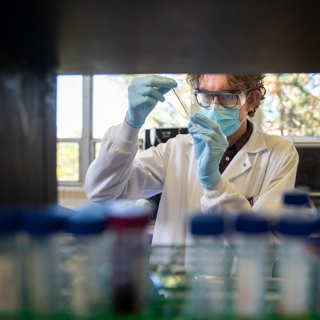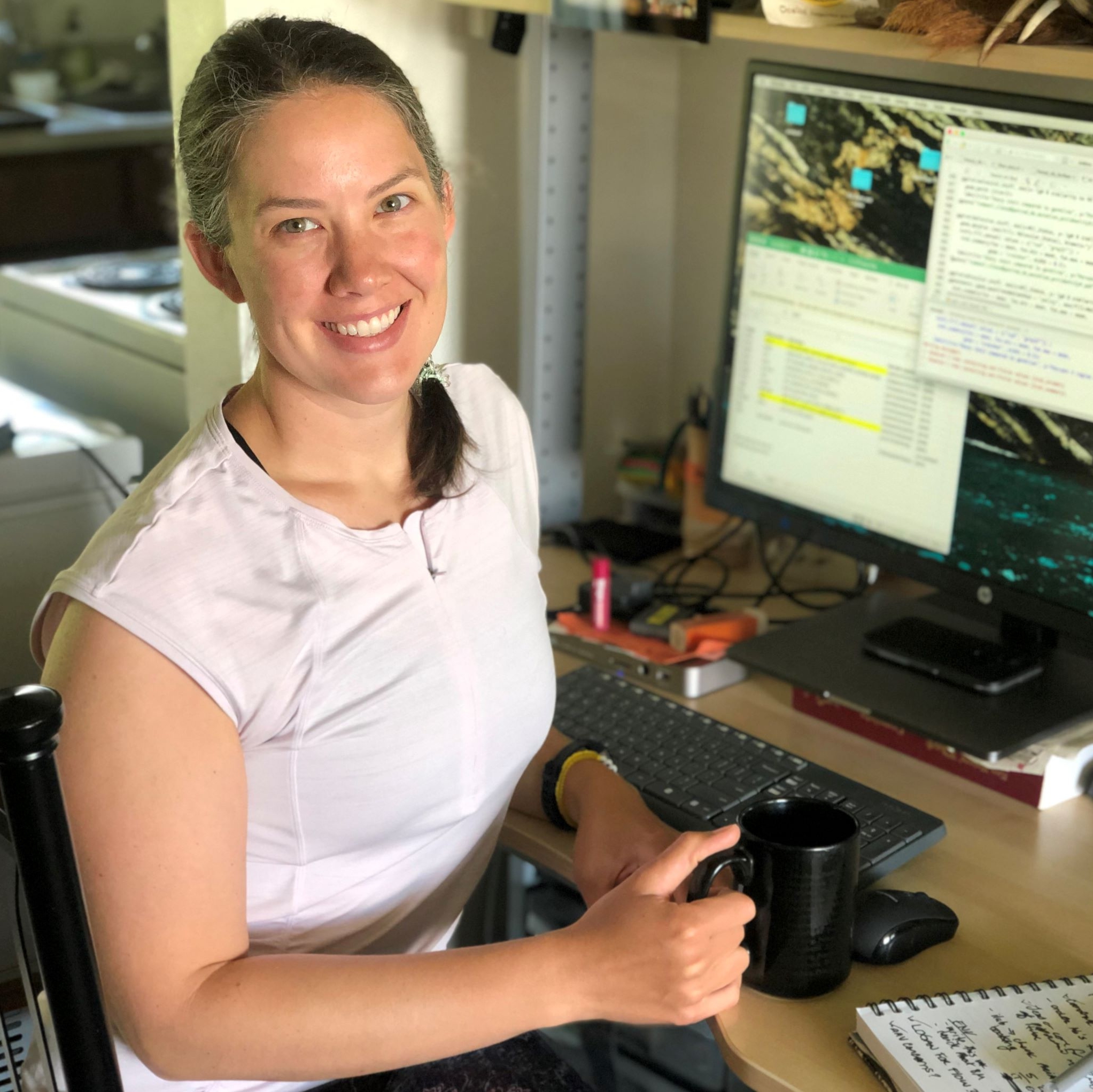Faculty & Students
Blair DeBuysscher
Assistant Research Professor
Contact
- Office
- Skaggs 390C
- Blair1.debuysscher@umontana.edu
- Office Hours
Open door policy
Personal Summary
Dr. DeBuysscher completed her Ph.D. at the University of Montana in partnership with Rocky Mountain Laboratories, NIAID, NIH, where she studied virology and vaccine design creating a effective vaccine against Nipah virus. Upon completion of her degree, she joined the Vaccine and Infectious Disease Division at Fred Hutchinson Cancer Research Center as a postdoctoral fellow. At the Hutch, Blair worked to understand the naïve response to HIV vaccination and infection, leveraging the ability to detect antigen-specific B cell with vaccine design to aid in creating a next generation HIV vaccine. Blair then moved back to Montana and joined forces with Dr. Evans where she is currently continuing her work to better understand the interplay between vaccine design and how to modulate the adaptive response. Dr. DeBuysscher is currently a research professor in the department of Biomedical and Pharmaceutical Science and part of the Center for Translation Medicine.
Education
B.S. Biology; Hillsdale College (2008)
Ph.D. Molecular Virology; Graduate Partnership Program University of Montana and Rocky Mountain Laboratories (2014)
Postdoctoral Fellowship, Immunology; Fred Hutchinson Cancer Research Center (2018)
Research Interests
My main interests focus on understanding the interplay between host and pathogen in the context of vaccination and infection. This work spans pathology, molecular biology, virology, and immunology. In recent years, I have focused more closely on the adaptive immune response, specifically in-depth characterization of the B cell response. I leverage antigen-specific B cell enrichment methods which allows for identification and isolation of B cells specific for proteins of subunit vaccines. This method allows us to identify cell that have responded to vaccination and track how this population changes over time. This system is a great way to evaluate the health and robustness of a B cell population as well as determine how changes made to a vaccine, for example the use of different adjuvants, affect this population. By combining this technique with single-cell sorting and sequencing, we can pair flow-based phenotype data with individual BCR sequences, gaining novel insight into the clonality and phenotype of antigen-specific B cells post-vaccination. Specifically, by following the vaccine antigen-specific B cell response over time, we aim to better understand the effects of novel adjuvants on the downstream adaptive response. By comparing adjuvanted, we aim to create an adjuvant fingerprint that can then be used to choose the best adjuvant for a future vaccine. Current work focuses on Toll Like Receptor (TLR) agonists as adjuvants. These molecules act as immunomodulators binding either TLR 4, 7 or 8 and can easily be formulated (alone or in combination) with antigen to create an effective subunit vaccine. Current studies include vaccines targeting influenza, Pseudomonas, Covid and fentanyl.
Publications
Full list can be found at DeBuysscher_Publications.
DeBuysscher BL, Scott DP, Rosenke R, Wahl V, Feldmann H, Prescott J. 2021 Nipah Virus Efficiently Replicates in Human Smooth Muscle Cells without Cytopathic Effect. Cells. 25:10.
DeBuysscher BL*, Steach HR*, Schwartz A, Boonyaratanakornkit J, Baker ML, Tooley MR, Pease NA, Taylor JJ. 2020. Cross-Reactivity with Self-Antigen Tunes the Functional Potential of Naive B Cells Specific for Foreign Antigens. J Immunol. 204: 498-509. *co-first authors
Bancroft T, DeBuysscher BL, Weidle C, Schwartz A, Wall A, Gray M, Feng J, Steach J, Fitzpatrick K, Gewe M, Skog P, Doyle-Cooper C, Ota T, Strong R, Nemazee D, Pancera M, Stamatatos L, McGuireA, Taylor T. 2019. "Detection and in vivo activation of naive HIV-1 broadly neutralizing antibody precursor B cells using anti-idiotypes." J Exp Med. 216:2 331-2347.
Schountz T, Campbell C, Wagner K, Rovnak J, Martellaro C, DeBuysscher BL, Feldmann H, Prescott J. 2019. Differential innate immune response elected by Nipah virus and Cedar virus correlate with disparate In Vivo pathogenesis in hamsters. Viruses. 11: e291.
DeBuysscher BL, Scott D, Thomas T, Feldmann H, Prescott J. 2016. Peri-exposure protection against Nipah virus disease using a single-dose recombinant vesicular stomatitis virus-based vaccine. NPJ Vaccines. 1. 16002
Borisevich V, Lee B, Hickey A, DeBuysscher B, Broder CC, Feldmann H, Roxkx, B. 2016. Escape From Monoclonal Antibody Neutralization Affects Henipavirus Fitness In Vitro and In Vivo. J Infect Dis. 213: 448–55.
Prescott J, DeBuysscher BL, Feldmann F, Gardner DJ, Haddock E, Martellaro C, Scott D, Feldmann H. 2015. Single-dose live-attenuated vesicular stomatitis virus-based vaccine protects African green monkeys from Nipah virus disease. Vaccine 33: 2823–2829.
DeBuysscher BL, Scott, D, Marzi, Z, Prescott, J, Feldmann H. 2014. Single-dose live-attenuated Nipah virus vaccines confer complete protection by eliciting antibodies directed against surface glycoproteins. Vaccine 22: 2637-44.
Prescott J, DeBuysscher BL, Brown KS, Feldmann H. 2014. Long-term single-dose efficacy of a vesicular stomatitis virus-based andes virus vaccine in Syrian hamsters. Viruses 6: 516–23
Xu K, Rockx B, Xie Y, DeBuysscher BL, Fusco DL, Zhu Z, Chan Y-P, Xu Y, Luu T, Cer RZ, Feldmann H, Mokashi V, Dimitrov DS, Bishop-Lilly KA, Broder CC, Nikolov DB. 2013. Crystal structure of the Hendra virus attachment G glycoprotein bound to a potent cross-reactive neutralizing human monoclonal antibody. PLoS Pathog. 9: e1003684.
DeBuysscher BL, de Wit E, Munster VJ, Scott D, Feldmann H, Prescott J. 2013. Comparison of the pathogenicity of Nipah virus isolates from Bangladesh and Malaysia in the Syrian hamster. PLoS Negl. Trop. Dis. 7: e2024.
Ammann C, Messer R, Varvel K, DeBuysscher BL, Lacasse R, Pinto A, Hasenkrug K. 2009. Effects of acute and chronic murine norovirus infections on immune responses and recovery from Friend retrovirus infection. J. Virology, 24: 13037-41.

